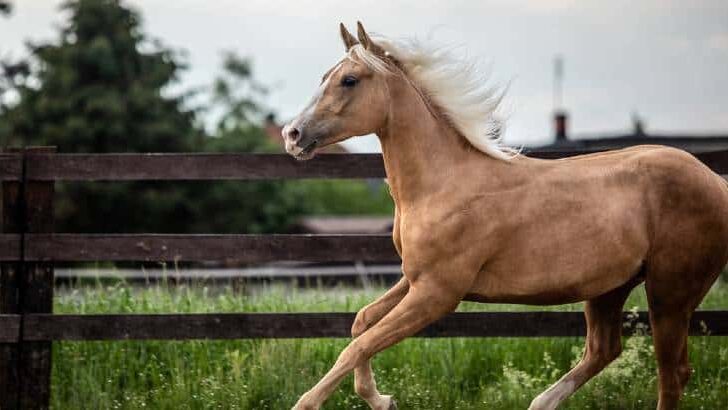Affiliate Disclaimer
As an Amazon Associate I earn from qualifying purchases. It helps me keep the website going. Thank you for your support.
The Quarter Horse is a versatile and dynamic breed of American origin that is used in a broad range of disciplines. The exact breeds and bloodlines that make up Quarter Horses have frequently been a topic for debate. A common question; is a Quarter Horse a warmblood? Let’s find out.
Although Quarter Horses are descendants of Warmbloods, they are not strictly considered to be Warmbloods. To be considered a Warmblood, a breed needs to have a balanced combination of warm-blooded breeds such as Arabians, and cold-blooded breeds such as Draught horses. Quarter Horses do not have sufficient inclusion of cold-blooded breeds to meet the definition of a warmblood.
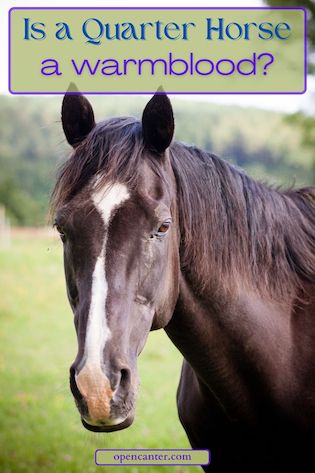
What is a Quarter Horse?
Let’s delve a little deeper into exactly what a Quarter Horse is and whether they are a warmblood. This breed originated from the States in the 1600s from an equal mix of Spanish Barb and English stock. In a quarter-mile race, this breed could outrun most other breeds by reaching speeds of up to 55mp/h (88km/h) This is how the Quarter Horse got its name.
They are one of the oldest breeds in American history and typically stand between 14.3hh and 16hh. They were initially recognized for their sprinting ability and later also became a favored breed for their temperament, level-headedness, and for being sure-footed.
In the 1900s, Thoroughbreds overtook Quarter Horses to become the recognized breed best for sprinting over long distances. Quarter Horses, on the other hand, gained popularity for Western riding.
The American Quarter Horse Association (AQHA) was formed in 1940 and led to the official registration of the breed and its increasing popularity in the years that followed. By the late 20th century, more than 2,5 million horses were registered in this AQHA’s stud book. The purpose of the AQHA is to protect the pedigree of ranch horses.
The modern Quarter Horse has a heavy muscular composition and a broad chest. They are used as working horses on ranches and trail riding as well as for more competitive disciplines like dressage and showjumping.
They can be found in 17 different recognized colors with the most common being buckskin, bay, and chestnut. The Quarter Horse is considered to be the first breed developed in the United States.
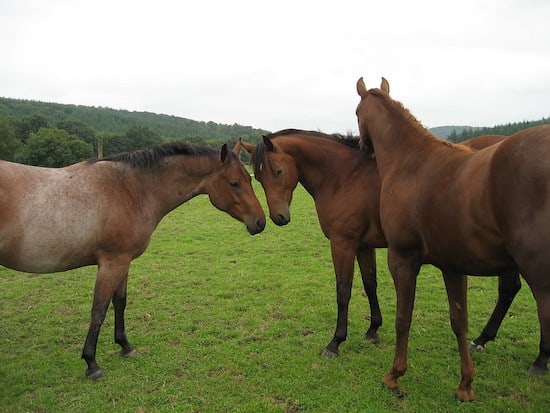
What are The Different Types of Quarter Horses?
There are three main types of Quarter Horse:
The stocky, ‘bulldog’ type
The stocky type is shorter and more compact while still being agile. This type of Quarter Horse is commonly used as a stock horse or for farm and ranch activities. They have incredibly strong hindquarters that allow them to turn quickly and also contribute to their speed when working with cattle.
The halter type:
The halter type is slightly taller than the stocky type, while still being muscular. As the name suggests, this type is used for halter competitions. They have small heads and refined muzzles. They are typically between 15.2 and 16hh.
There has been debate over the years whether the way this type of Quarter Horse has a muscle mass that is disproportionate to its size. This excess weight could cause additional pressure on its skeletal system and lead to other ailments.
The racing and hunter type:
Quarter Horses have been bred to run short distances of between 220 to 800 yards at high speeds. The racing type is most commonly used for this purpose as they have slightly longer legs and a leaner stature. Quarter horses who race typically race against their own breed and not with breeds such as Thoroughbreds.
The show hunter type is slightly slimmer and has a closer resemblance to a Thoroughbred. They are used to compete in show hunter and jumping events.
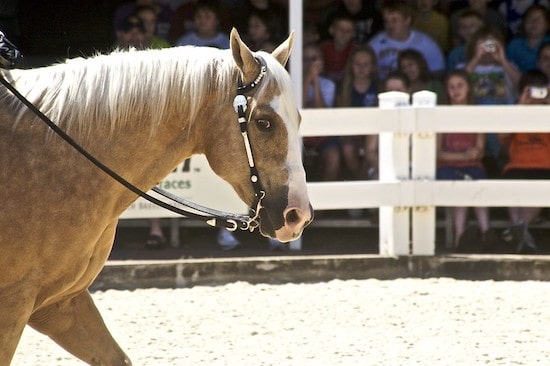
What is a warmblood?
Rather than referring to a specific type of breed, the term ‘warmblood’ refers to a number of different breeds with the same characteristics. Warmbloods are known for their solid confirmation, calm temperaments, and athletic ability.
The modern Warmblood that you will come across today is a result of intentional and selective breeding in order to achieve its confirmation and temperament.
Originally a highly strung horse, Warmbloods originate from a hotblooded horse that was known for being more challenging to handle. To counteract and balance this, they were bred with a calmer, cold-blooded type of horse such as a draught horse.
After many years of refining the balance of these traits, the modern Warmblood bloodline refers to a clever and sporty horse with a calm demeanor that excels in equestrian disciplines such as showjumping, eventing, and dressage. You can read more about warmblood horses here.
What is the difference between a Quarter Horse and a Warmblood?
A Quarter Horse originates from bloodlines that include the English Stock and Spanish Barb. These are considered to be hot-blooded breeds.
A Quarter Horse’s breeding, over many years, has not included a sufficient amount of cold-blooded breeds in order to achieve the balance of a Warmblood’s breeding. This is the differentiating factor between the two breeds and also the key to understanding whether a Quarter Horse is a Warmblood.
What is special about a Quarter Horse?
One of the key features that make a Quarter Horse unique is its speed. They can reach speeds of up to 55 mph (88km/h) over short distances.
They have also illustrated a keen ‘cow sense’ in terms of their natural ability to work alongside cattle. This means they have a knack for anticipating the movement and behavior of cattle before the rider reacts. This is a natural intuition that all Quarter Horses have.
Quarter Horses also make really great family horses and are the most popular breed in the United States and Canada. Quarter Horses are known for being easy keepers.
This means that they do not require very specific or extensive care in order to thrive. They keep weight on fairly easily through a standard diet of roughage and horse feed which means they are fairly cheap to own.
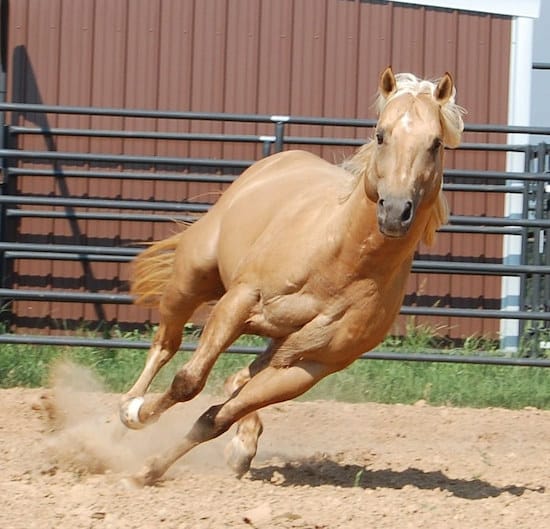
What disciplines are Quarter Horses used for?
The stocky and compact build of the Quarter Horse makes it a popular choice for Western riding and disciplines such as barrel racing, reining, cutting, and calf roping. It is also a popular choice for English riding disciplines such as pleasure riding, dressage, and showjumping.
Which discipline they are used for depends on the type, and therefore build, of a particular Quarter Horse. There are very few breeds that can match this kind of suitability to such a broad range of uses and equestrian disciplines.
10 Interesting Facts about Quarter Horses
- Texas has the largest population of Quarter Horses in the United States which is also the county with the largest number of Quarter Horses. The countries with the second and third largest populations of this breed are Canada and Germany, respectively.
- Almost every Quarter Horse’s breeding can be traced back to one famous stallion. His name was Pete McCue, he was born in 1895 and he was known for his athleticism and striking looks.
- Quarter Horses have a decent lifespan of 15 to 20 years which is higher than most other breeds. This is due to their wide gene pool and breeding selection.
- One of the most successful racehorses in the world was a Quarter Horse. He was named Easy Jet and he ran a total of 38 races of which he won 27. He was given the title of World Champion Quarter Horse as well as Champion Stallion when he was just a two-year-old colt. These titles are seldom given to horses so young.
- The AQHA has broad criteria for the types of horses it includes in its registry. It has, for example, included registration of horses that are a mix of Quarter Horse and Thoroughbred. These horses are included in an appendix to the registry and can compete in events exclusive to Quarter Horses.
- Quarter Horses exist in almost every possible shade and color. Their most unique colors include Palomino, Silver, Champagne, and Appaloosa while the most common color is sorrel which is reddish/brown.
- A Quarter Horse of decent breeding that has not received much training costs approximately $3,500 in the United States while a well-trained Quarter Horse can cost as much as $10,000. This excludes the purchase of any equipment or tack.
- Quarter Horses may have not been discovered for their keen ‘cow sense’ if it wasn’t for Thoroughbreds. As Thoroughbreds became increasingly popular and recognized for their racing ability, Quarter Horses were pushed out West in the States. This pushed them into the Western Riding spotlight and is how their cow sense and natural ability to handle cattle was discovered.
- Quarter Horses played a large part in establishing Rodeo as a popular event in the equestrian world. Rodeo is now a significant part of the American horse world.
- Although a significant breed with millions of registered horses, the Quarter Horse breed is less than 100 years old. There are more than five million horses registered across 95 different countries.
Final Thoughts
Having unpacked a little more about this unique and versatile breed, and considering the question; ‘Is a Quarter Horse a Warmblood’, we can conclude that the answer is no. Although it includes many similarities and breeding lines, Quarter Horses are not included in the definition of a Warmblood.

